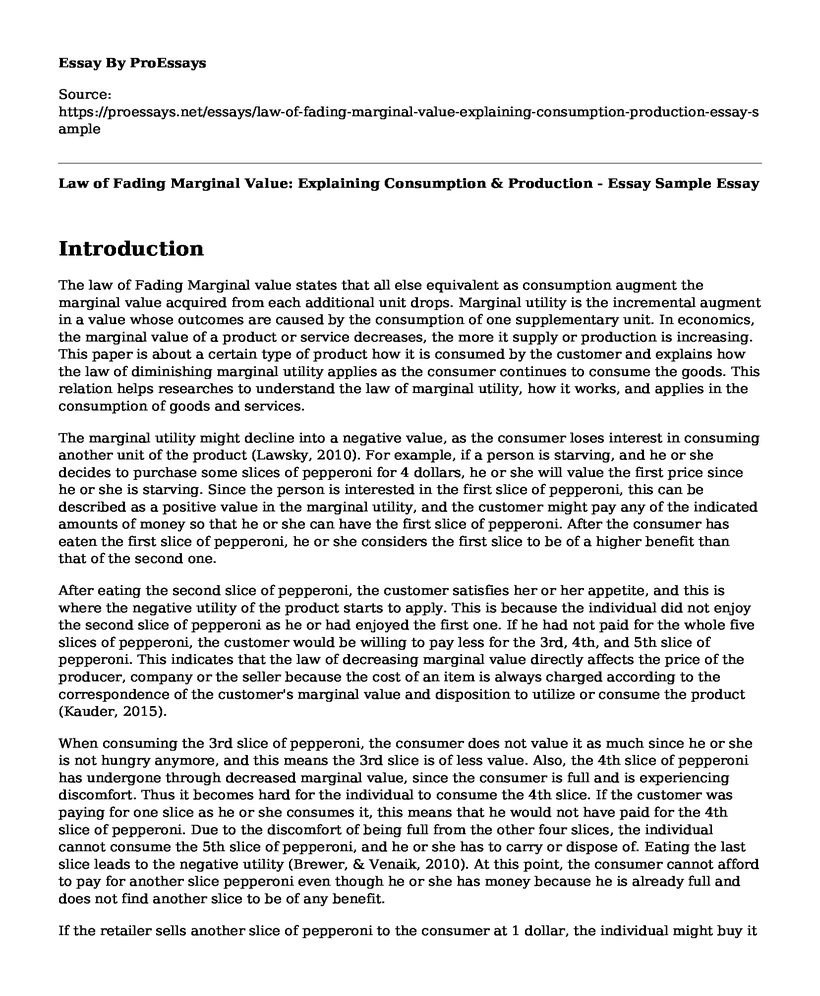Introduction
The law of Fading Marginal value states that all else equivalent as consumption augment the marginal value acquired from each additional unit drops. Marginal utility is the incremental augment in a value whose outcomes are caused by the consumption of one supplementary unit. In economics, the marginal value of a product or service decreases, the more it supply or production is increasing. This paper is about a certain type of product how it is consumed by the customer and explains how the law of diminishing marginal utility applies as the consumer continues to consume the goods. This relation helps researches to understand the law of marginal utility, how it works, and applies in the consumption of goods and services.
The marginal utility might decline into a negative value, as the consumer loses interest in consuming another unit of the product (Lawsky, 2010). For example, if a person is starving, and he or she decides to purchase some slices of pepperoni for 4 dollars, he or she will value the first price since he or she is starving. Since the person is interested in the first slice of pepperoni, this can be described as a positive value in the marginal utility, and the customer might pay any of the indicated amounts of money so that he or she can have the first slice of pepperoni. After the consumer has eaten the first slice of pepperoni, he or she considers the first slice to be of a higher benefit than that of the second one.
After eating the second slice of pepperoni, the customer satisfies her or her appetite, and this is where the negative utility of the product starts to apply. This is because the individual did not enjoy the second slice of pepperoni as he or had enjoyed the first one. If he had not paid for the whole five slices of pepperoni, the customer would be willing to pay less for the 3rd, 4th, and 5th slice of pepperoni. This indicates that the law of decreasing marginal value directly affects the price of the producer, company or the seller because the cost of an item is always charged according to the correspondence of the customer's marginal value and disposition to utilize or consume the product (Kauder, 2015).
When consuming the 3rd slice of pepperoni, the consumer does not value it as much since he or she is not hungry anymore, and this means the 3rd slice is of less value. Also, the 4th slice of pepperoni has undergone through decreased marginal value, since the consumer is full and is experiencing discomfort. Thus it becomes hard for the individual to consume the 4th slice. If the customer was paying for one slice as he or she consumes it, this means that he would not have paid for the 4th slice of pepperoni. Due to the discomfort of being full from the other four slices, the individual cannot consume the 5th slice of pepperoni, and he or she has to carry or dispose of. Eating the last slice leads to the negative utility (Brewer, & Venaik, 2010). At this point, the consumer cannot afford to pay for another slice pepperoni even though he or she has money because he is already full and does not find another slice to be of any benefit.
If the retailer sells another slice of pepperoni to the consumer at 1 dollar, the individual might buy it and decide to carry the 5th and 6th slices. This is because the consumer is aware that he or she might feel hungry after some hours and consume the other slices that he bought at a lower price. The consumer is conscious that if he buys the slice at 1 dollar instead of 4 dollars, it will save him some money next time when he is hungry. This means that the price decreases as the consumer loses interest in the product, and this results in a negative utility.
References
Brewer, P., & Venaik, S. (2010). GLOBE practices and values: A case of diminishing marginal utility?. Journal of International Business Studies, 41(8), 1316-1324. Retrieved from https://link.springer.com/article/10.1057/jibs.2010.23
Kauder, E. (2015). History of marginal utility theory. Princeton University Press. Retrieved from https://books.google.com/books?hl=en&lr=&id=XDTWCgAAQBAJ&oi=fnd&pg=PP1&dq=Law+Of+Diminishing+Marginal+Utility+in+economics&ots=mut5op8BIv&sig=ZZ6qmroq9RaPfqsK4woYMcz8Bk0
Lawsky, S. B. (2010). On the edge: Declining marginal utility and tax policy. Minn. L. Rev., 95, 904. Retrieved from https://heinonline.org/hol-cgi-bin/get_pdf.cgi?handle=hein.journals/mnlr95§ion=22
Cite this page
Law of Fading Marginal Value: Explaining Consumption & Production - Essay Sample. (2023, May 06). Retrieved from https://proessays.net/essays/law-of-fading-marginal-value-explaining-consumption-production-essay-sample
If you are the original author of this essay and no longer wish to have it published on the ProEssays website, please click below to request its removal:
- Research Paper on Federal Bureau of Investigation
- Research Paper on Al-Qaeda
- Victim Participation in the Criminal Justice System Essay Example
- Research Paper on Violence and Brutality on the US-Mexico Borders
- Essay Example on African Americans and Criminal Justice: Unequal Representation and Its Impact
- Regulatory Takings: A Constitutional Right of Private Property Owners - Essay Sample
- Compare and Contrast Essay on Cultural Relativism vs. Universalism: A Debate on Human Rights







